|
These are a few of the many species of wildflowers decorating the surface at Jewel Cave National Monument. Wildflowers can be found around the Visitor Center, Historic Area and along the surface trails. Remember that picking wildflowers is illegal in all National Park Service areas. Please be a responsible plant lover and take pictures not flowers. Theodore Roosevelt said it best,"...wild flowers should be enjoyed unplucked where they grow." *Indicates that this plant is an nonnative or invasive plant in South Dakota. More information about exotic plants can be found at Exotic Plant Managment. 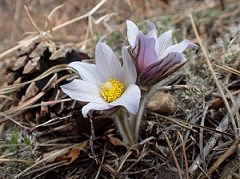
NPS Photo Pasqueflower Scientific Name: Anemone patens Family: Buttercup (Ranunculaceae) Bloom: March - May Alternate Names: May Day Flower, Prairie Crocus, Wind Flower, Easter Flower, Meadow Anemone The Pasqueflower was declared South Dakota's official state flower in 1903. One of the first to bloom in the spring this flower is a beautiful sign that winter has ended. The white to deep lavender petal-like sepals can open up to 3 inches. The stem is covered with silky hairs, which helps to insulate this wildflower in the cool spring temperatures. 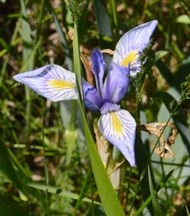
NPS Photo Rocky Mountain Iris Scientific Name: Iris missouriensis Family: Iris (Iridaceae) Bloom: May - June Alternate Names: Western Blue Flag, Flag Lily, Liver Lily, Water Flag, Wild Iris Rock Mountain Iris is sparsely seen throughout the Monument's trails. This showy wildflower has a slender stem, sword-shaped leaves, and large delicate lilac to purple flowers. It's roots and stem can be toxic, the plant produces strong and flexible fibers that are perfect for making cordage for fishing nets, rope, snares, and string. 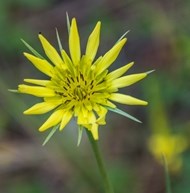
NPS Photo Goatsbeard* Scientific Name: Tragopogon dubius Family: Aster (Asteraceae) Bloom: May - August Alternate Names: Western Salsify, Star of David, Wild Oyster Plant, Noonflower Introduced from Europe, and naturalised in the United States, this striking yellow flower generally blooms in disturbed areas. During the seeding process this wildflower looks like a giant dandelion. The sticky, milky juice from the 1 to 3 foot tall stem was used by the Plains Indians as a remedy for indigestion. 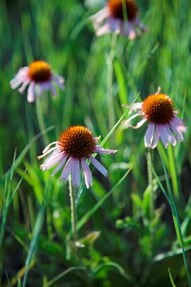
NPS Photo Purple Coneflower Scientific Name: Echinacea angustifolia Family: Aster (Asteraceae) Bloom: June - July Alternate Names: Black Sampson, Echinacea Purple Coneflowers can be seen along the Canyons Trail, Roof Trail and in abundance in the Historic area. The bristly stem can reach 1 to 2 feet tall attaching to a spiky dome-like head with drooping pink-purple petals. 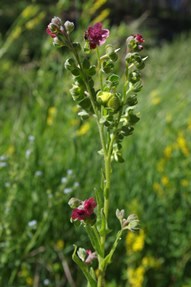
NPS Photo Hound's Tongue* Scientific Name: Cynoglossum officinale Family: Borage (Borainaceae) Bloom: June - July This dull reddish-purple toxic plant was introduced from Europe and can be seen mainly in the Historic Area of the Monument. The flowers of this plant are produced along the coiled stalks of the plant that can grow 1 to 4 feet tall. If ingested, animals will be poisoned and the bur-like seeds act like Velcro and stick to animals and clothing. 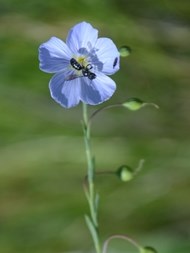
NPS Photo Wild Blue Flax Scientific Name: Linum lewisii Family: Flax (Linaceae) Bloom: June - August Alternate Names: Prairie Flax, Lewis Flax, Meadow Flax This showy blue wildflower is desirable for many animals including deer, antelope and multiple bird species. Blue Flax is aesthetically pleasing to the eye and is very beneficial for erosion control. This species of wildflower can be used as a fire suppressant when it is in the semi-evergreen stage. 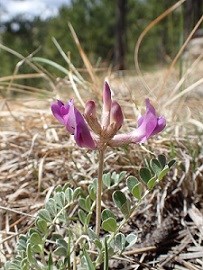
NPS Photo Missouri Milkvetch Scientific Name: Astragalus missouriensis Family: Pea (Fabaceae) Bloom: June - August This short-stemmed plant grows low to the ground and has gray-green to whitish leaves. The rose to purple flowers are enclosed by hairy pointed sepals. The distinct seed pods are oblong and inflated, growing brown and leathery as they mature. 
NPS Photo Gunnison's Mariposa Lily Scientific Name: Calochortus gunnisonii Family: Lily (Liliaceae) Bloom: June - August The Gunnison's Mariposa Lily has a delicate, three petaled white flower that blooms at the top of a slender stem. This tulip-like wildflower can be a sweet and nutritious snack for many animals. 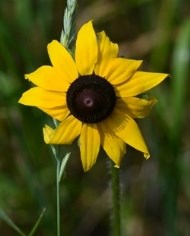
NPS Photo Blackeyed Susan Scientific Name: Rudbeckia hirta Family: Aster (Asteraceae) Bloom: June - August The Black Eyed Susan wildflower is found throughout the Black Hills and is used in areas prone to erosion along hill sides and road sides. This bright-yellow wildflower can grow 1 to 2 feet tall with a brown sphere-shaped head 2 ½ inches in width.
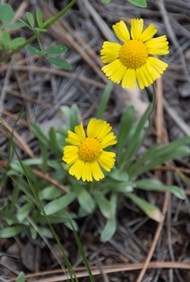
NPS Photo Stemless Hymenoxys Scientific Name: Tetraneuris acaulis Family: Aster (Asteraceae) Bloom: June - September This wildflower prefers nearly soil-free area, and can be found growing among the rocks along the Roof and Canyons trails. The Stemless Hymenoxys are less than a foot tall and display a bright yellow flower from the stemless stalk. 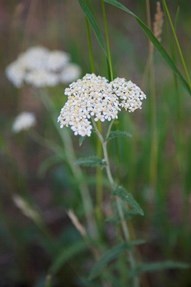
NPS Photo Common Yarrow* Scientific Name: Achillea millefolium Family: Aster (Asteraceae) Bloom: June - September Alternative Names: Milfoil, Western Yarrow Common Yarrow can be seen throughout the Monument, but is most common around the Historic Area and along the Canyons Trail. The tiny white flowers form in an umbrella-like cluster and can grow 1 to 3 feet tall. When the fern-like leaves are crushed the smell of herbs fills the air.
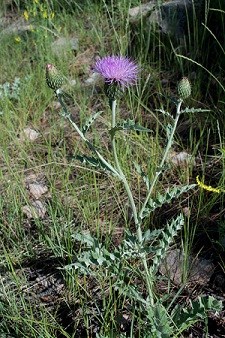
NPS Photo Wavyleaf Thistle Scientific Name: Cirsium undulatum Family: Aster (Asteraceae) Bloom: June - September Wavyleaf Thistle is one of the few native thistles that can be seen throughout Jewel Cave National Monument. When the flowers are in bloom they attract many species of butterflies. This plant grows 3 to 4 feet tall with the flowers varying in colors from lavender to pink. Although Flodman's Thistle looks very similar, Wavyleaf Thistle tends to have a creamy white color and wavy leaves. 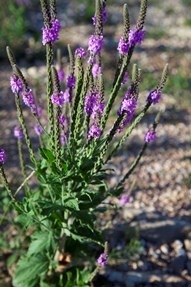
NPS Photo Wooly Verbena Scientific Name: Verbena stricta Family: Vervain (Verbenaceae) Bloom: June - September Alternate Names: Wooly Vervain, Hoary Vervain These beautiful purple pencil-like wildflowers attract many species of bees and butterflies to the Monument. Wooly Verbena can grow 1 to 4 feet tall with noticeable purple flowers blooming at the peak of the five spreading lobes. 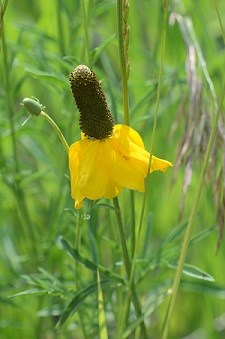
NPS Photo Prairie Coneflower Scientific Name: Ratibida columnifera Family: Aster (Asteraceae) Bloom: July - August Alternate Names: Mexican Hat, Long-Head Coneflower, Columnar Prairie Coneflower The eye-catching Prairie Coneflowers can be seen along the Canyons and Roof Trails, and along Highway 16 as it winds through the Monument. This wildflower can sometimes reach up to four feet tall. The flower head is a dome-like cylinder disk with 10 to 12 bright yellow petal drooping down as soon as they develop. 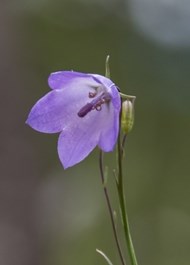
NPS Photo Harebell Scientific Name: Campanula rotundifolia Family: Bellflower (Campanulaceae) Bloom: July - August Alternate Names: Bluebell, Bluebell-of-Scotland, Blue Rain Flower, Heathbells, Witches Thimbles Harebells are usually found in small groups of two or three plants and can be seen on the Roof Trail, Canyons Trail, and throughout the Historic Area. This delicate wildflower can grow about 15 inches high forming a bell-shaped blossom at the top in varying shades of blue to lavender. 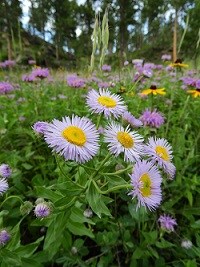
NPS Photo Threenerve Fleabane Scientific Name: Erigeron subtrinervis Family: Aster (Asteraceae) Bloom: July - August Fleabanes are common throughout the Black Hills and tend to inhabit open forests. With three prominent nerves extending the length of each lance-shaped leaf, this plant is aptly named. Each flower head contains 100 to 150 purple or lavender ray florets, surrounding many yellow disc florets. At times, the flower heads reach over two inches in diameter, making it a showy display. 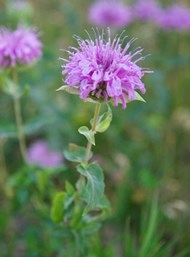
NPS Photo Wild Bergamot Scientific Name: Monarda fistulosa Family: Mint (Lamiaceae) Bloom: July - August Alternate Names: Horsemint, Beebalm This native light purple wildflower can be seen on the Roof Trail, Canyons Trail and surrounding the surface in the historic area. Growing in large patches, the large rose to purple colored flowers stand out among other plants. The flowers grow at the end of the 1 to 3 foot tall square stems with lance shaped leaves. 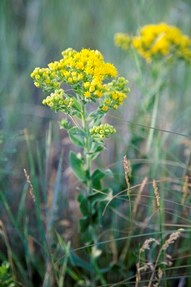
NPS Photo Stiff Goldenrod Scientific Name: Solidago rigida Family: Aster (Asteraceae) Bloom: July - September This beautiful late summer wildflower can be found in abundance along the Roof and Canyons trails. Stiff Goldenrod attracts many species of bees and other insects, as it is a vital source of pollen and nectar. The small yellow flowers typically grow in large clusters on this 12 to 24 inch tall plant.
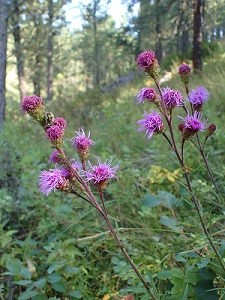
NPS Photo Rocky Mountain Gayfeather Scientific Name: Liatris lingulistylis Family: Aster (Asteraceae) Bloom: Late July - September Alternate Names: Rocky Mountain Blazing Star The brilliant purple flowers of this plant grow in dense spikes with long wavy bracts. The stem can be 8 to 30 inches tall and is covered with long spear-like leaves. This unique Dr. Suess-esque flower is very alluring to monarchs and other butterflies. |
Last updated: May 19, 2021
